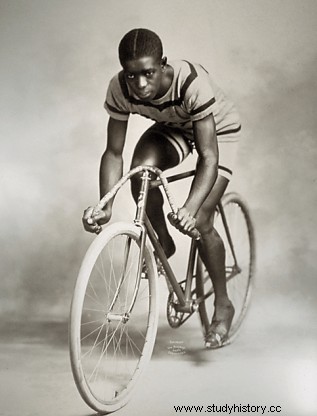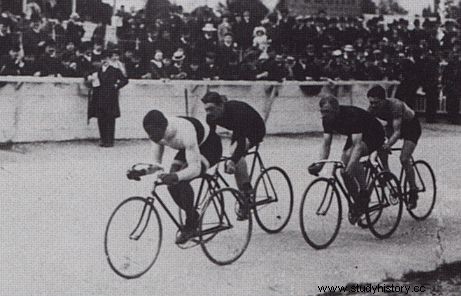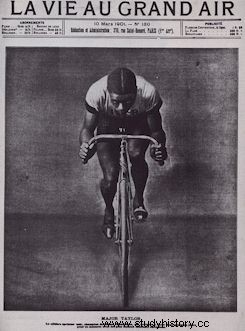In 1865, the Thirteenth Amendment to the United States Constitution was passed. which officially abolished and outlawed slavery in the United States of America and, with limited exceptions (such as those convicted of a crime), outlawed involuntary servitude. But on a day-to-day basis, especially in the southern states, racial prejudice still existed.
Marshall Walter Taylor was born on November 26, 1878, in the state of Indiana. His father, Gilbert , the son of a Kentucky slave, fought for the Union in the Civil War and later worked as a coachman for the Southards , a wealthy family from Indianapolis. When Taylor was a boy, he used to accompany his father to help him with the horses and became close friends with Dan , the Southards' son of the same age. In fact, when Marshall was 8 years old, he even moved into the Southards' house where he received the same education as Dan. Those happy memories were cut short when the family moved to Chicago and Marshall had to return to his house... to the harsh reality. At the age of 13 he had to go to work to help the family economy and he did it as a newspaper delivery boy with the bicycle that the Southards had given him when they left. That bicycle became his inseparable companion.

A savvy local merchant, owner of Hay and Willits bike shop He noticed Marshall's knack for doing flips and stunts on his bike, so he hired him to make displays at the store's door to attract customers. At exhibitions he dressed in a military uniform and from that moment he kept the nickname " Major «. The store where he worked was sponsoring a local cycling competition and on the day of the race Tom Hay, his boss, took him, in theory, just to see it... when they arrived he pointed out:at 13 years old, Marshall "Mayor" Taylor won his first competition with overwhelming superiority. For a few more years he kept working at the store and competing in some amateur races but at 17 he met Louis Munger , a former cyclist and bicycle manufacturer, who would become his manager and, above all, a good friend.
Munger signed him up to compete in a professional race in Indianapolis…although only whites could compete. At first they thought to kick him out but then they decided it would be better to let him participate... What was a black amateur going to do against white professionals? At the age of 17 he broke two track records (one thousand and one fifth mile). Although the response of the organizers was to prohibit him from participating again and not validate those records, now everyone knew the Black Cyclone . Munger took it to Worcester (Massachusetts) where he had the factory and competed in New York in a six day endurance test, he managed to finish but they decided that he would not compete in it anymore in this type of tests. But what he did achieve in New York was to turn professional.

In 1897 he began to compete on the national circuit, but the color of his skin caused him many limitations:the promoters of the tests in the South prevented him from participating, many other competitors insulted him and threw him off his bike in the middle of the race, one even came to him to grab his neck and left him unconscious (he was fined $50)... But not only in the competition, when he bought a house in a good neighborhood of Worcester the neighbors made a collection to buy it back for $2000 more, some hotels they refused to host him… Still, Taylor set seven world records, won 29 of the 49 races he contested as a professional and in 1899 he won the World Championship in Montreal (Canada). His fame jumped to Europe and French promoters wanted to hire him and, although he was reluctant at first, he agreed on the condition that he not compete on Sunday – he was a devout follower of the Baptist Church. In 1902 he competed on the European circuit – on equal terms with the whites – winning most of the races in which he entered and cementing his reputation as the best cyclist in the world. The European tour continued to Australia to become the highest paid athlete of the time ($ 30,000 annually).

Cover of a French newspaper
In 1910, at the age of 32, Taylor was retiring. Some business failures, the crash of '29, the separation of his wife and his illness left the Black Cyclone alone and ruined. For a few years he survived by selling his autobiography The Fastest Bicycle Rider in the World on the streets. . In 1932, at age 53, he died and was buried in a mass grave at Chicago's Mount Glenwood Cemetery. Years later, a group of former professional cyclists who knew Taylor's history exhumed his remains and buried them in an individual grave with a bronze plaque that reads:
To the World Cycling Champion who overcame the difficult road without hate in his heart. Honest, brave, believer, clean-living and gentlemanly sportsman. A memory of his career in which he always gave his best. You're gone but we don't forget you.
